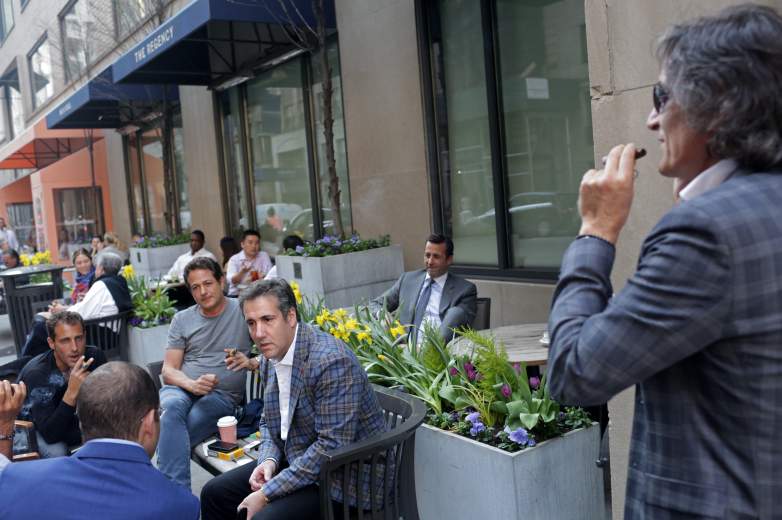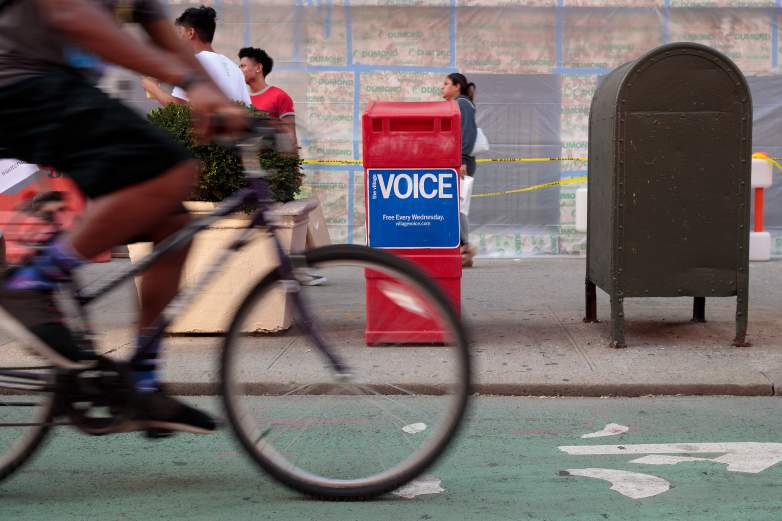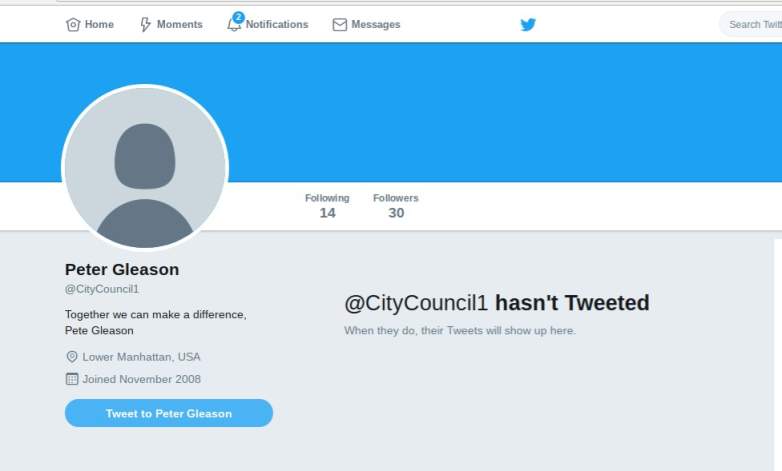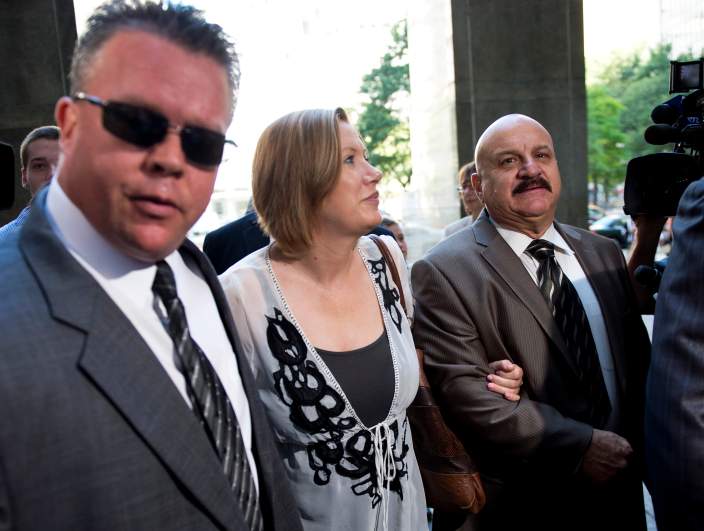
LinkedIn Peter J. Gleason
U.S. District Court Judge Kimba M. Wood denied lawyer Peter J Gleason’s request to block access to communication between he and embattled attorney Michael Cohen related to two alleged victims of now-former New York Attorney General Eric Schneiderman.
There was fairly instant speculation when he filed the request earlier this month that the New Yorker exposé that led to Schneiderman’s resignation wherein four women accused him of physical, emotional, verbal and sexual abuse, two on the record, may have come from the Cohen and/or the Trump camp. The authors say that didn’t happen but one, Ronan Farrow, says it’s “…no surprise there were other investigations—legit ones and political smears—as allegations were so widespread.” He also says they had “no knowledge of Gleason.”
It’s complicated, but here’s what you need to know about Gleason’s connection to Donald Trump and his lawyer Michael Cohen, Schneiderman, a longtime NY tabloid reporter named Steve Dunleavy, and, Gleason himself:
1. Gleason Wanted Talks he Had With Trump Attorney Cohen About Former NY AG Schneiderman Kept Under Wraps. Judge Wood Ruled Against Him
Gleason’s motion letter to Judge Kimba M. Wood, the judge handling the Michael Cohen case in the Southern District of New York district court, asked her to block access to what he discussed with Cohen about Schneiderman specifically their talks about two women who Gleason claimed came to him in 2012 and 2013 alleging they were abused by Schneiderman. Gleason said he told the first woman that came to him, “…how invariably the very entities that were established to protect would ultimately turn on her to protect the power elite including Schneiderman.”
Since Cohen’s home, office and hotel room were searched by the FBI and documents and other items seized, those discussions and what occurred may wind up public.

GettyEric Scheiderman
Gleason claims that a “logical recommendation” would have been to report the allegations to the New York District Attorney, then as now Cyrus Vance, but Gleason said “based on my past experience Past experience in reporting prima facie political corruption that was ignored by the office, some of which were ultimately prosecuted elsewhere. I wanted these women to be believed about the horrific experiences with Schneiderman that wouldn’t be brushed under the rug.” He said he discussed it with Stephen Dunleavy longtime tabloid reporter, New York Post columnist under owner Rupert Murdoch, and ‘A Current Affair’ tabloid TV host “who suggested and offered to discuss the matter with Donald Trump,” Gleason wrote the judge.
“Mr. Dunleavy did indeed discuss the matter with Mr. Trump as evidenced by a phone call I received from attorney Michael Cohen. During my conversations with Cohen I shared with him certain details of Schneiderman’s vile acts on these women. The extent of Mr. Cohen memorializing any communications is unknown. However these two women’s confidentiality as victims of sexual assault should be superior to that of any unrelated subpoena. Gleason asks Wood to to issue “a protective order and seal” of any correspondence he had with Cohen “regarding our communications which pertain to Schneiderman’s assault on these two women.”

Michael Cohen at Loews Regency hotel on Park Ave on April 13, 2018 in New York City. Following FBI raids on his home, office and hotel room.
Tweeted by reporter Adam Klasfeld, the immediate questions on Twitter included why did Gleason’s friend Dunleavy suggest they talk to Trump, why did Cohen get involved, why not suggest the women go to police, and finally, there’s speculation about the timing of the New Yorker story where four women accuse Schneiderman and the letter to the court from Gleason coming a few days afterward.
Journalists Farrow and Janet Mayer took to Twitter to respond:
2. A Lawyer Admitted to the NY Bar in 2009, Gleason is a Former NYPD Officer & FDNY Firefighter & Fire Marshal
According to his LinkedIn page and other documents including court files, Gleason was a sworn New York City police officer from 1983 to 1986. In 1986, he joined the FDNY as a firefighter but was assigned to “light duty” as a result of medical issues for a period of time and also shifted from fire-fighting to fire code enforcement and investigation as a fire marshal. He parted ways with the in 1996.
He was also a Coast Guard reservist for two decades, his LinkedIn says.
Gleason attended the City University of New York Law School, the years are not listed on his bio, but began to practice law in 2004 and was admitted tot he New York Bar Association in 2009.
3. Gleason, Who Ran Unsuccessfully for NYC Council in 2009, Blamed a Scorching Expose By The Village Voice For His Loss. The Voice Investigation Raised Myriad Questions About Gleason

GettyVillage Voice newspaper stand in the East Village neighborhood in Manhattan, August 22, 2017. The Village Voice, one of the oldest and most well-known of the alternative weekly newspapers, announced today that it will no longer publish a print edition. The publication will maintain a continued online and digital presence. (Photo by Drew Angerer/Getty Images)
The Village Voice, a then free weekly New York City ink-on-paper publication, which ceased print operation in 2017, ran a damming profile of Gleason in the months before a 2009 city council election.
Voice reporter Wayen Barrett wrote, “Gleason has magically emerged from the shadows as a serious contender though his career so far has been, to put it kindly, shadowy.” Barrett, an infamous New York muckraker and authority on Donald Trump—as evidenced by his years of reporting on the then-developer and his published tome about Trump and as was noted in the January 2017 New York Times story that announces his death at age 71; “Barrett’s voluminous background files from the Trump biography, and his professional courtesy, made his Brooklyn home a mecca for investigative reporters during the recent presidential campaign.”
Gleason had claimed his decade as a firefighter in the Lower East Side District 1 neighborhood demonstrated why he was the best candidate.
“Gleason’s big claim to fame is that he was a firefighter at Ladder Company 11 in the district for 10 years, during which he says he visited 90 percent of the buildings in the district, ‘checking out conditions or responding to calls,’”Barrett wrote in 2009. “He’s boasted that this service enabled him to ‘know the district well,’ establishing his connections to a neighborhood he only moved into two years before he first ran to represent it.”
“But a Voice review of his FDNY records reveals that he was an active firefighter in the district for only a bit more than three years and that his department record is riddled with long stretches of time when he was either on leave or light duty, far away from the Lower East Side firehouse that he cites as the nexus of his relationship to the community,” Barrett reported.
“By the time Gleason retired on a full disability pension in November 1996 (while in his second year at Queens Law School), he had already taken nearly 49 months of paid medical leave or light-duty assignments, cutting short his FDNY career by over four years.”
Barrett also outed Gleason for posting images of himself in “full firefighter regalia on 9/11, though he’d actually left the department five years earlier.”
In one case, Gleason was injured and reaped, Barrett reported, a hefty settlement and used the money to dive into the New York real estate market.
“By his own count, he made almost a million-dollar profit on the sale of two East 80th Street apartments in 2007, minus taxes, which he complained about bitterly in a Voice interview,” he wrote. “Between the settlement and the disability pension, the accident, as painful as it might have been, was the biggest payday of his life.”
Barrett wrote Gleason’s legal career as a lawyer, celebrated on his (since removed campaign website) is similarly mysterious.”
Barrett reported Gleason began law school in 1995 and after a decade to earn his degree and pass the bar, was admitted to practice in 2004.
“Other than a series of sometimes bizarre cases brought either by him or a small law firm he is associated with to this day — once attempting to overturn his own failing grade in a law school class, and another time when he tripped over a hose in a Home Depot store — he has a scant legal history,” he wrote.

Peter J Gleason Twiiter 2009
Gleason said Barrett’s story cost him the election.
4. Gleason Unsuccessfully Sued the FDNY Afterwards Claiming It Had Illegally Leaked His Medical Records to a Reporter

Peter J Gleason, 2009, Facebook photo.
In 2012, Gleason filed a lawsuit against City of New York, FDNY, former Battalion Chief George Belnavis, Lieutenant Edward Boles, Fire Marshal Brian Grogan , Captain Patrick Reynolds, former Fire Commissioner Nicholas Scoppetta and the Uniformed Fire Officers Association.
In his lawsuit, Gleason alleged “the defendants tried to discredit his campaign for City Council in 2009 by releasing his confidential medical records to the press to show that he spent most of his ten year tenure with the department on medical leave.”
Gleason argued that since he represented a former firefighter in a action against the FDNY which he said was, at the bottom, a political retribution case, the FDNY had it in for him and stole and leaked his medical records to the Voice.
A 2012 report detailed the case: “These medical records are confidential and protected from unlawful government search and seizure and public dissemination by federal statute and by the Fourth Amendment to the U.S. Constitution.” Gleason claims he drew the ire of the FDNY by suing them on behalf of his colleague and client William Kregler, the report read.
“Kregler claimed that the FDNY violated his First Amendment rights by retaliating against him by terminating his application for appointment to the position of City Marshal because of his public support of Robert Morgenthau who was then a candidate for District Attorney,” the complaint read, according to the report.
The case was dismissed, although a court said he could bring an Americans With Disabilities Act case. It’s not clear if he ever did as he’d have to prove a disability.
5. Gleason Represented the ‘Soccer Mom Madam’ Anna Gristina & Offered Her His $2.5 Million Apartment as Bail Collateral

Anna Gristina, the woman dubbed the “Manhattan Madam,” arrives at court with a body guard and arm-in-arm with well-known private investigator Vincent ‘Vinnie’ Parco, August 16, 2012 in New York. Peter J. Gleason was her attorney.
Gleason offered up his then $2.5 million apartment as bail collateral for then-alleged madam, Anna Gristina in 2012. While he would later leave the case as her pro bono lawyer, at the time, Gleason, as reported by The Guardian, initially was her attorney.
The case received a lot of attention at the time as Gristina was alleged to have been the “mastermind of a high-end Manhattan prostitution ring,” it was reported. Gleason was reported to have offered up his apartment for her to be her “saviour” since while she was held at Rikers Island her “life was in danger after a story got round that she employed underage girls,” Gleason said.
Known at the time as the “Soccer Mom Madam,” Gristina pleaded guilty to running an Upper East Side brothel but what she’s most likely know for today is the story about how Charlie Sheen, who was infected with HIV, Page Six reported, had sex with a number of Gristina’s prostitutes in 2009 and 2010 without condoms and would pay extra for it. Sheen said he discovered he was HIV-positive in 2011.
“He could have given HIV to dozens of girls,” Gristina told Page Six.
“The porn girls he liked would agree to go bareback [without protection] because he gave them an extra $5,000, $10,000. And some of them would agree because they were hoping they would get pregnant,” Page Six reported Gristina said. “He would give girls incentives not to use protection, and the girls would try to please him because they wanted to come back.”
.



